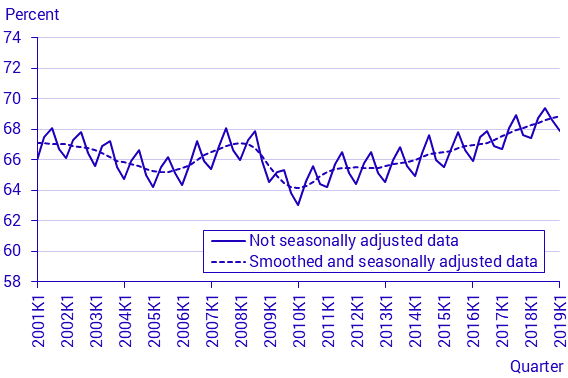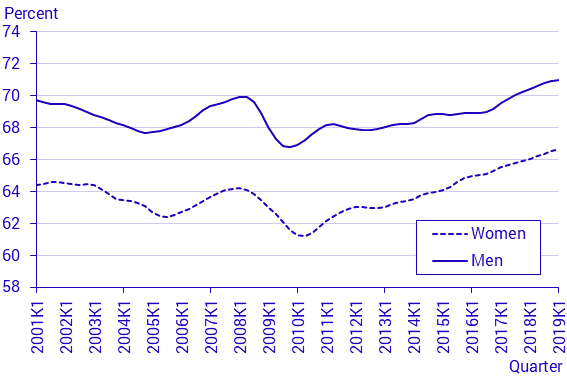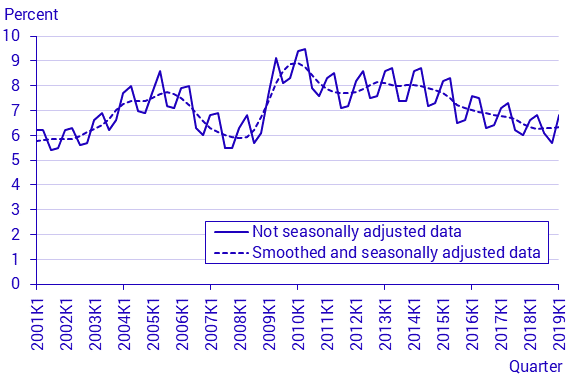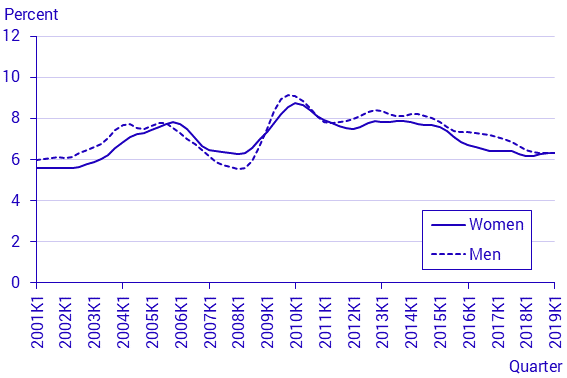Labour Force Surveys (LFS), 1st quarter 2019
Labour market participation rate higher among both Swedish born and foreign born persons
Statistical news from Statistics Sweden 2019-05-14 9.30
The number of employed persons aged 15-74 years increased by 69 000 persons between the first quarter of 2019 and the first quarter of 2018, non-seasonally adjusted, and the unemployment rate was 6.8 percent. The number of hours worked increased by 2.2 percent, calendar adjusted. Smoothed and seasonally adjusted data shows that employment increased, while the unemployment rate showed a minor change and amounted to 6.3 percent.
The figures in this statistical news release are based on collected data that contains quality deficiencies. Revised LFS figures have been published and are available here:
Labour Force Surveys
The labour force
The number of persons in the labour force aged 15-74 years amounted to 5 454 000 in the first quarter of 2019, non-seasonally adjusted. This is an increase of 83 000 compared to the same quarter of 2018. The number of women in the labour force increased by 44 000 to 2 594 000 and the number of men in the labour force increased by 38 000 to 2 860 000. The relative participation rate rose by 0.6 percentage points and amounted to 72.8 percent. Among women, this rate increased by 0.7 percentage points to 70.4 percent and among men the participation rate amounted to 75.0 percent.
Seasonally adjusted and smoothed data also shows a continued increase in the number and share of persons in the labour force compared with adjacent quarters. In the first quarter of 2019, there were 5 506 000 persons in the labour force, which corresponds to 73.5 percent of the population.
Employment
In the first quarter of 2019, there were 5 086 000 employed persons aged 15-74 years, non-seasonally adjusted. This is an increase of 69 000 compared to the first quarter of 2018. The number of employed women increased by 36 000 to 2 422 000 and the number of employed men increased by 33 000 to 2 664 000. The employment rate increased by 0.5 percentage points to 67.9 percent; among women the rate increased by 0.6 percentage points to 65.8 percent and among men the employment rate amounted to 69.9 percent.
Seasonally adjusted and smoothed data shows an increase in both the number and share of employed persons compared with adjacent quarters. In the first quarter of 2019, there were 5 158 000 employed persons, which corresponds to an employment rate of 68.8 percent.
Employees
In the first quarter of 2019, there were 4 595 000 employed persons, non-seasonally adjusted, which is an increase of 65 000 persons compared with the corresponding period last year. The number of employed women increased by 35 000 to 2 283 000 persons. The number of employed men increased by 30 000 and amounted to 2 312 000 persons. The number of permanent employees increased by 73 000 to 3 885 000. The number of permanently employed women increased by 36 000 to 1 890 000 and the number of permanently employed men increased by 37 000 to 1 995 000. The number of temporary employees amounted to 710 000, among which there were 393 000 women and 317 000 men.
Seasonally adjusted and smoothed data shows an increase in the number of permanent and temporary employees.
Hours worked
The total number of hours worked averaged 162.1 million per week, according to non-seasonally adjusted data in the first quarter of 2019. In calendar-adjusted figures, this corresponds to an increase of 2.2 percent compared with the first quarter of 2018.
Seasonally adjusted and smoothed data shows an increase in the number of hours worked. In the first quarter of 2019, the number of hours worked averaged 158.2 million hours per week.
The majority of employed persons have an agreed working time of 35 hours or more per week, or full-time work. In the first quarter of 2019, there were 3 945 000 persons working full-time, which is an increase of 76 000 persons compared to the same quarter of 2018. The number of men working full-time increased by 30 000 to 2 260 000 and the number of women working full-time increased by 46 000 to 1 685 000. In total, 345 000 persons worked short part-time (1-19 hours) and 775 000 persons worked long part-time (20-34 hours).
The average actual hours worked among employed persons aged 15-74 years amounted to 31.9 hours per week in the first quarter of 2019. This is an increase of 0.2 hours compared to the corresponding quarter in 2018. Among women, the number of hours worked increased by 0.5 hours per week to 29.4 hours and among men the number of hours worked was 34.1.
Underemployment
Among employed persons aged 15-74 years, 222 000 were underemployed in the first quarter of 2019. Among women, this number decreased by 11 000 to 112 000, and there were 110 000 underemployed men. Underemployed persons accounted for 4.4 percent of employed persons.
Unemployment
In the first quarter of 2019, there were 368 000 unemployed persons aged 15-74 years, non-seasonally adjusted. This corresponds to an unemployment rate of 6.8 percent. There were 172 000 unemployed women and 196 000 unemployed men. The unemployment rate amounted to 6.6 percent among women and 6.9 percent among men.
Among persons aged 15-74 years, the changes in seasonally adjusted and smoothed data were minor in relation to previous quarters. In the first quarter of 2019, there were 348 000 unemployed persons, which corresponds to an unemployment rate of 6.3 percent.
There were 100 000 long-term unemployed persons (who were unemployed for at least 27 weeks) aged 15-74 years in the first quarter of 2019, non-seasonally adjusted. Among men, there were 57 000 and among women there were 43 000.
There were 118 000 unemployed young persons aged 15-24 years, non-seasonally adjusted. Youth unemployment increased by 2.1 percentage points to 20.1 percent. Among unemployed young persons, 80 000 were full-time students, which is an increase of 15 000 compared to the corresponding quarter in 2018.
Among young persons aged 15-24 years, seasonally adjusted and smoothed data shows an increase in the number of unemployed persons and in the share of unemployed persons compared with adjacent quarters. There were 110 000 unemployed persons, which corresponds to an unemployment rate of 17.6 percent.
Not in the labour force
The group 'not in the labour force' includes persons who are not classified as employed nor as unemployed. In the first quarter of 2019, there were 2 040 000 persons not in the labour force, a decrease of 31 000 compared with the corresponding period in 2018. There were 952 000 men and 1 088 000 women in this group, a decrease of 22 000 women.
Among persons not in the labour force, there were 949 000 retired persons. There were 640 000 full-time students, an increase of 23 000 compared with the first quarter of 2018. There were 258 000 persons who reported that they were on long-term sick leave, which is down by 27 000 persons.
Latent job seekers
Among persons not in the labour force, there are persons who have not looked for work in the past four weeks, but who want to and are able to work. These are not classified as unemployed, but rather in the group of latent job seekers. There were 106 000 latent job seekers aged 15-74 years in the first quarter of 2019. Among young people aged 15-24 years, there were 53 000 latent job seekers, which is down by 11 000 compared with the first quarter of 2018.
Unused labour supply
Unemployed persons, underemployed persons and latent job seekers together comprise the unused labour supply. In the first quarter of 2019, the unused labour supply averaged 16.3 million hours per week. The unused labour supply corresponds to 408 000 full-time employments with 40-hour work weeks.
Labour market for persons aged 20-64 years
The population covered by the LFS is comprised of persons aged 15-74 years. However, labour market participation among younger and older in this age group is considerably lower for natural reasons, for example that this group contains large shares of students and retired persons. To better approach what can be seen as the core of the actively working population, the situation of the age group 20-64 years is described in the following section.
The relative participation rate among persons aged 20-64 years increased by 0.7 percentage points and amounted to 87.3 percent in the first quarter of 2019, non-seasonally adjusted. Among women the relative participation rate was 85.0 percent, an increase of 0.9 percentage points, while the corresponding figure among men was 89.6 percent, an increase of 0.6 percentage points. Seasonally adjusted and smoothed data shows a continued increase in the participation rate, which amounted to 88.0 percent.
In the first quarter of 2019, the share of employed persons aged 20-64 years was 82.1 percent, non-seasonally adjusted, which is an increase of 0.7 percentage points compared with the corresponding period last year. Among women, the employment rate was 80.1 percent, up by 0.8 percentage points. Among men, the employment rate was 84.1 percent, up by 0.6 percentage points. Seasonally adjusted and smoothed data shows a continued increase in the employment rate, which amounted to 83.0 percent.
According to non-seasonally adjusted data, the unemployment rate in the age group 20-64 years was 6.0 percent. Among women, the unemployment rate was 5.8 percent and among men it was 6.2 percent. In relation to adjacent quarters, seasonally adjusted and smoothed data shows a minor change in the share of unemployed persons, which amounted to 5.6 percent.
Swedish born and foreign born persons aged 20-64 years
The relative participation rate among Swedish born persons aged 20-64 years increased by 0.5 percentage points and amounted to 88.9 percent in the first quarter of 2019, non-seasonally adjusted. Among Swedish born women, the relative participation rate was 87.5 percent and among Swedish born men it was 90.3 percent. Among foreign born persons aged 20-64 years, the relative participation rate increased by 1.7 percentage points and amounted to 82.4 percent in the first quarter of 2019. Among foreign born women, the participation rate increased by 1.9 percentage points and amounted to 77.6 percent, and among foreign born men, it increased by 1.5 percentage points and amounted to 87.4 percent. Seasonally adjusted and smoothed data shows a continued increase of the participation rate in both groups. The participation rate amounted to 89.6 percent among Swedish born persons and 83.1 percent among foreign born persons.
In the first quarter of 2019, the share of employed persons among Swedish born persons aged 20-64 years was 86.1 percent, non-seasonally adjusted, which is an increase of 0.7 percentage points compared with the corresponding period last year. Among Swedish born women the employment rate was 84.9 percent, which is an increase of 0.7 percentage points, and among Swedish born men the employment rate was 87.2 percent, which is an increase of 0.6 percentage points. Among foreign born persons, the employment rate was 69.8 percent. Among foreign born men the employment rate was 74.0 percent and among foreign born women it was 65.7 percent. Seasonally adjusted and smoothed data shows a continued increase of the employment rate compared with adjacent quarters among both Swedish born and foreign born persons. In the first quarter of 2019, the employment rate was 87.0 percent among Swedish born persons and 70.7 percent among foreign born persons.
The relative unemployment rate among Swedish born persons aged 20-64 years was 3.2 percent in the first quarter of 2019. Among Swedish born women unemployment amounted to 3.0 percent and among men it was 3.4 percent. Unemployment among foreign born persons amounted to 15.3 percent, and there was no difference in the figure for men and for women. According to seasonally adjusted and smoothed data, unemployment among Swedish born persons was 2.9 percent. Unemployment among foreign born persons amounted to 14.9 percent.




Feel free to use the facts from this statistical news but remember to state Source: Statistics Sweden.
